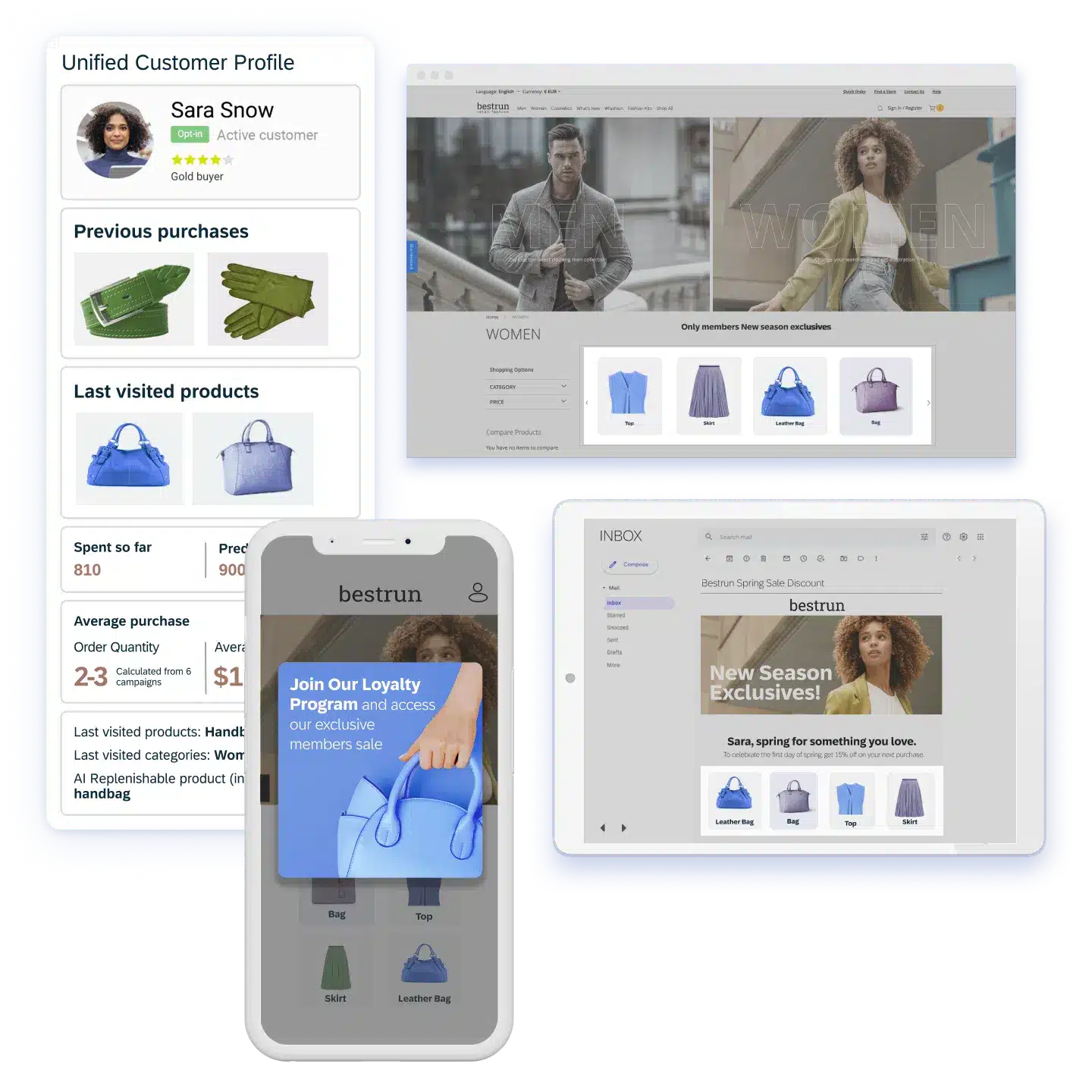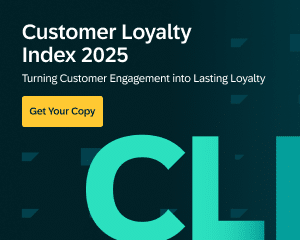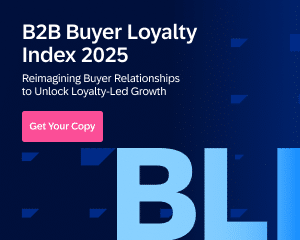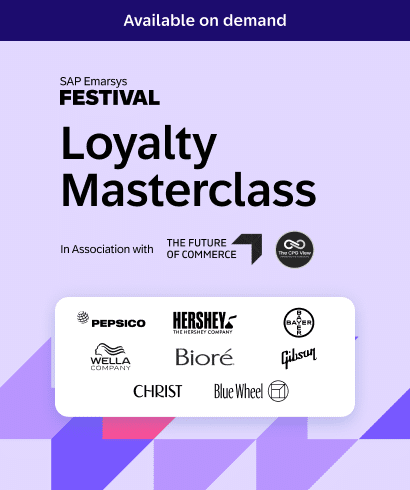The difference between a one-time visitor and a loyal repeat customer often comes down to personalized touches that make the journey more relevant and enjoyable.
In this article, we’ll explore e-commerce personalization examples that show how brands can stand out by delivering hyper-relevant interactions at each stage of the customer lifecycle.
We’ll start by examining how personalization directly improves the overall customer experience. Then, we’ll explore nine specific strategies—from targeted emails to dynamic pricing—that e-commerce marketers can implement quickly.
Whether you’re looking for a simple entry point or advanced tactics to refine your existing efforts, these examples will help you craft memorable, high-converting experiences at scale.
How does E-Commerce Personalization Improve Customer Experience?
Personalization in e-commerce is all about aligning products, content, and promotions with individual preferences. By leveraging data-driven insights, marketers can design frictionless shopping journeys that resonate with each customer, increasing satisfaction, loyalty, and revenue. Let’s take a quick look at some examples of e-commerce personalization in action:
PUMA used Emarsys to deliver one-to-one campaigns, fine-tuning their messaging for each subscriber’s past purchases and interests. The result? A 5x increase in revenue and 50% database growth within six months.
—Read more about how Puma achieved this within 6 months of adopting SAP Emarsys.
Levi’s prioritized personalization in its post-purchase outreach, focusing on style recommendations and special offers. By sending timely reminders for new arrivals that match past orders, they drastically boosted repeat purchases.
—Here’s how Levi finds the right fit to improve the repurchase rate.
Why personalization matters
- Higher engagement: People are more likely to interact with messaging that speaks to their needs.
- Improved conversion rates: When customers see relevant products at the right moment, they’re more likely to buy.
- Enhanced loyalty: Personalized experiences cultivate a sense of belonging, turning casual shoppers into brand advocates.
By anchoring your strategy in data and tailored interactions, you can transform your e-commerce site into a platform that entices first-time visitors and keeps loyal customers coming back for more.
8 Types Of E-Commerce Personalization
In this section, we’ll explore eight examples of e-commerce personalization, each with a brief definition, implementation tips, pros and cons, and real-life case studies. You can choose which methods best align with your brand’s goals or adopt several for a more holistic strategy.
For additional inspiration on leveraging these strategies in a broader marketing context, take a look at our e-commerce marketing strategies and review our customer engagement strategies in e-commerce.
The different types of e-commerce personalization can include but are not limited to:
1. Product recommendations
Essentially, this is an automated “digital salesperson” guiding the shopper to relevant products.
How does it work? An AI engine—like the one in SAP Emarsys––drives conversion and revenue with personalized product recommendations. Its AI marketing capabilities enable you to combine historical and real-time data to build a proper view of every customer. Using visual affinity, channels, and purchase predictions. SAP Emarsys recommends products tailored to each customer while maintaining consistency across multiple channels, from email to web to mobile.

Real-world success
- Total Tools drove a 12% revenue uplift by using AI-driven product recommendations in both onsite and email channels. (Details here)
- Feel Good Contacts realized a 22% jump in email revenue through improved suggestions. (Learn more)
- Versuni targeted B2B buyers with personalized recommendations, boosting average order value by 25%. (Check it out)
Implementation tips
- Embed widgets on your homepage, product pages, and cart pages to display “Recommended for You” or “Customers Also Bought.”
- Use email marketing to send personalized product picks post-purchase or upon cart abandonment.
- Continuously monitor product recommendation performance (clicks, conversions, revenue lift) to optimize campaign performance.
2. Personalized email campaigns
Unlike generic email blasts, personalized email campaigns segment recipients based on factors like demographics, purchase history, or browsing behavior. Each email arrives with content and offers relevant to the individual’s context.
How they work
- Segmentation: Divide subscribers into categories (e.g., high-value repeat customers vs. first-time buyers).
- Dynamic content: Pull in real-time product data, location-specific promotions, or unique discount codes.
- Behavior triggers: Automate sends for cart abandonment, post-purchase follow-ups, or loyalty milestones.
Real-world success
- AO saw a 150% increase in newsletter engagement by tailoring emails to customer interests. (Read how)
- John Frieda achieved 4x greater reach for product launches via custom emails. (Case study)
- Pour Moi boosted their active customer database by 16% in the first month using custom campaigns. (Success story)
Implementation tips
- Use personalization tokens (e.g., first name, recently viewed items).
- A/B test subject lines and content blocks to see which variant resonates most with each segment.
- Incorporate location data to highlight region-specific shipping info or local store events.
3. Personalized homepages and landing pages
When a returning visitor lands on your site, the homepage (or specific landing page) changes based on their profile, past interactions, or location—offering tailored visuals, product highlights, or calls-to-action.
How do they work? A personalization engine checks cookies, browsing data, purchase history, user account info, and other points of reference to dynamically display content blocks or promotional banners aimed at each individual.
Using product affinity, channels, and purchase predictions, SAP Emarsys AI recommends products, content, and offers tailored to individual customers while maintaining consistency across multiple channels. Learn more about how it works.
Real-world success
- Petco expanded personalized experiences across homepages and landing pages, increasing brand loyalty and repeat visits. They achieved a 15% increase in won-back customers, a 31% increase in revenue overall, and more. (See details)
Implementation tips
- Greet returning users by name or reference previous items they viewed.
- You can switch up banner images and hero text for different segments.
- Integrate real-time inventory data to highlight availability in the user’s local store.

4. Dynamic pricing strategies
Dynamic pricing allows e-commerce stores to adjust prices in real-time based on supply, demand, user behavior, or even loyalty status. While it can be sophisticated, dynamic pricing is a powerful tool for maximizing profits without scaring off price-sensitive customers.
How do they work? Algorithms scan market conditions and user data, automatically tweaking prices to align with business objectives. For example, they might move slow-selling inventory or give exclusive discounts to top-tier loyalty members.
Real-world success
- Levi’s has implemented strategies (including refined pricing approaches) to keep customers coming back, boosting repurchase rates. They achieved +15,000 customers with repurchase and engagement tactics. Check out how Levi finds the right fit to improve the repurchase rate.
Implementation tips
- Segment wisely: Offer small discounts to cart-abandoners if that’s proven to push them over the finish line.
- Monitor competitors: Monitor external pricing to avoid significant discrepancies customers could see as gouging.
- Test before full rollout: Dynamic pricing can be polarizing if implemented abruptly.
5. Behavioral targeting ads
Behavioral targeting shows ads to people based on their interests or behaviors—like products they’ve looked at, visited pages, or items left in a cart.
How they work
- Data mining: Marketers collect user data from web sessions, email engagements, or social media interactions.
- Targeted campaigns: Ads highlight items or deals related to these behaviors, often retargeting individuals across multiple channels.
- Dynamic creative: With Dynamic Creative Optimization, ad layouts or headlines adapt in real-time to reflect the viewer’s preferences.
Real-world success
- Gibson exemplifies omnichannel engagement, leveraging fan/customer data to deliver the right content at the right time. Gibson had a 27% email impact on the business overall and gained 10% of total revenue driven by automation in one year. (Read more on Gibson’s approach)
Implementation tips
- Create lookalike audiences of high-value customers to expand your reach.
- Use frequency caps to avoid oversaturating the same audience with identical ads.
- Sync your CRM or CDP data with ad platforms (Google, Facebook, etc.) for real-time updates.
6. Tailored content and messaging
Tailored content personalizes everything from blog articles to push notifications based on user context—recent activities, preferences, or even time of day.
How it works
Marketing automation and real-time triggers combine to deliver the right message at the right moment. For instance, a sportswear brand might congratulate a user on completing a running milestone and suggest relevant gear.
Real-world success
- Adidas Running App uses real-time triggers for personalized notifications. They leverage SAP Emarsys’ platform to send tailored messages based on user activity, such as congratulatory emails after completing a run or reminders to stay active. (Learn more)
- Happy Socks scaled personalization across channels with automation by creating >300 automated emails, serving different touchpoints in the customer journey, and ensuring consistent brand vibes. They gained a +15% potential revenue uplift from active customers. (Case study)
- Adore Beauty uses cross-channel messaging for a seamless experience. (More Details)
Implementation tips
- Use journey mapping to identify key interaction points (first purchase, milestone achievements, membership anniversaries).
- Develop a library of messages tailored to these milestones.
- To maintain relevance, employ dynamic fields (e.g., user name, last purchased item, and local weather conditions).
7. Personalized push notifications
Push notifications are short, clickable alerts on mobile or desktop devices. Personalizing them involves sending context-aware messages that resonate with each user’s behavior or purchase patterns.
How they work
With a robust marketing platform, triggers are set based on user actions, such as app logins, location changes, or cart additions. The system then delivers relevant push messages (e.g., “Your item is back in stock!”).
Real-world success
- DJI achieved global scale in customer retention, likely leveraging personalized notifications for product updates. Some exciting achievements include a 44% increase in average order value 1.4x and an increase in web traffic (Learn more)
Implementation tips
- Combine user location data with prior purchase habits for timely alerts.
- Send re-engagement pushes to dormant users with relevant discounts or new arrivals.
- Test frequency to avoid push fatigue.
8. Personalized loyalty programs
Loyalty programs go beyond one-size-fits-all points systems by offering exclusive rewards tied to a shopper’s actual interests, purchase behavior, and brand interactions.
How they work
- Behavioral tracking: Record how often a user shops, which categories they favor, and how much they spend.
- Tiered perks: Provide escalating benefits for higher-value customers (e.g., early access to new collections).
- Surprise & delight: Occasionally issue random rewards to keep engagement high.
Real-world success
- Total Tools unified omnichannel data to strengthen loyalty. They achieved a 200% increase in loyalty sign-ups online (Success story)
- Adore Beauty uses an integrated loyalty program for contextual cross-channel experiences. (Details)

Implementation tips
- Combine loyalty data with email or SMS personalization for synergy.
- Offer bonus points for specific actions (writing a review, sharing on social, etc.).
- Use mobile wallet integrations for frictionless redemption.
Improve E-Commerce Personalization with SAP Emarsys
E-commerce personalization is a strategic necessity that fuels customer loyalty, higher conversions, and sustained growth. By applying the nine methods discussed, your brand can deliver more relevant, engaging experiences at every touchpoint.
If you want to streamline the process, consider SAP Emarsys’ e-Commerce Marketing Platform. With built-in AI, unified data management, and easy-to-use automation tools, SAP Emarsys makes personalized marketing fast and scalable—no massive development team is required.
Ready to see it in action? Book a demo today and learn how Emarsys can help you transform ordinary browsing sessions into meaningful customer journeys that boost loyalty and revenue.








